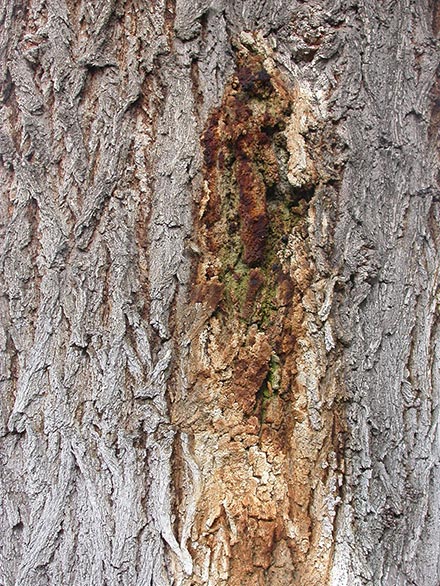 Introduction
Introduction
Oozing, bubbling, frothing, and bleeding of sap are all terms used to describe the symptoms of bacterial wetwood disease, also called “slime flux.” Wetwood is a common disease that affects the heartwood of poplars and elm trees in northern Nevada. Another disease that also causes bleeding, called alcoholic flux, affects primarily willows. With both diseases, bleeding can occur on the trunk, limbs, branch crotches, and wound areas.
What are the signs of infection?
Bacterial wetwood causes the wood of many hardwood and softwood trees to become water-soaked and bleed for long periods. The liquid that flows out is generally brown with a watery texture and has a slightly earthy scent. Liquid can flow from different parts of a tree from April through December and can change the texture and color of the affected bark. With continual bleeding, sections of bark change appearance, becoming stained with gray and brown streaks, and may appear crusty.
Bleeding is not the only visual sign of wetwood. The bacteria can cause yellowing and wilting of leaves in the upper canopy, and dieback can occur on severely infected branches. Some wetwood-infected trees will not bleed or show exterior signs of the disease until they become stressed or injured. In willow trees, the trunk or sections of a branch may froth or bubble with cream-colored foam with a distinct acidic, fermenting odor. This type of bleeding is known as “alcoholic flux,” and only lasts for a short period.
Alcoholic flux develops in the sapwood just below the bark and not in the heartwood. The ooze originates from shallow wounds. The flux can become sticky to slimy in texture, and often has a sweet, fermenting, beer-like smell. The discharge may attract many insects, which then feed on the ooze and use the moist areas to lay their eggs. Around willows, the most commonly observed insects are wasps and bees.
What trees are susceptible?
In northern Nevada, bacterial wetwood is frequently found in cottonwoods, aspens, and elms. However, fluxing diseases are also found in other species, including apple, birch, beech, hemlock, linden, mulberry, maple, oaks, Russian olive, and many others. Alcoholic flux is primarily found in willow trees.
How do trees become infected?
The mechanism of infection is not well understood. The bacteria that are associated with wetwood are commonly found in both water and soil. They can be spread by absorption through wounds on roots, pruning cuts and wood-boring insects.
Why does bleeding occur?
As the wetwood bacteria multiply, chemical reactions produce a number of fatty acids that change the tree’s internal gas system. Normal air pressure under the bark layer is between 5 pounds and 10 pounds per square inch (psi) in a healthy tree. With the presence of wetwood and the accompanying metabolic changes, the tree’s internal gas pressure can rise to as much as 60 psi. When stressed or wounded, or if the pressure becomes too intense, the bark will release the wetwood fluid at any weak point, especially at wounds. The liquid can take on different colors and foul odors depending on the number of secondary microorganisms (yeasts, fungi, bacteria) that colonize the tree.
Will my trees die?
In most cases, neither wetwood nor alcoholic flux is very serious. The diseases generally will not kill established trees. In cases where the bleeding originates on a branch, the continual dripping of moisture can kill areas of lawn or flowers directly below the drip.
However, bacterial wetwood can be costly when infected trees are used for lumber or paper production. Excessive amounts of moisture can change the color of the wood, staining the wood and producing a poor quality paper. Also, affected lumber has a tendency to split during the drying process.
In most cases, the effects of both diseases are primarily aesthetically displeasing, although insect infestations at the flux can become bothersome.
What can be done to control the disease?
There are no effective control methods for eliminating wetwood or alcoholic flux. In the past, it was recommended to drill a hole into the infected area of the tree and insert a rigid piece of plastic pipe to relieve the pressure and move the ooze away from the trunk. In recent studies, this has been found to cause damage to sap-conducting tissue, and the practice is no longer recommended.
Other remedies used in the past involved wrapping the wound or applying wound dressings. Neither of these approaches will stop bleeding nor prevent the disease from spreading.
If the damage is only apparent on a single branch, the infected area can be pruned out. However, pruning may not stop the fluxing. The bleeding can start again at the pruning cut (Fig. 3.) When pruning, be sure to disinfect all tools between cuts to reduce the chance of spreading disease. Tools may be disinfected by spraying with isopropyl alcohol, a 2-percent to 5-percent solution of household bleach, or a household disinfectant.
In most cases, it is best to leave the area alone and focus on maintaining the overall health of the tree. Steps should be taken to prevent damage to the root system and trunk, especially near the crown. Many susceptible tree species originated in riparian areas where they would receive plenty of moisture throughout the year. Trees planted in desert communities may lack adequate moisture. Drought conditions can increase stress and wetwood problems. Trees should be kept moist throughout the year to prevent stress. Established trees perform best when watered 12 inches to 18 inches deep and at least as wide as the canopy.
Hanson Mazet, W., and Donaldson, S.
2003,
Bacterial Wetwood and Alcohol Flux,
Extension, University of Nevada, Reno, FS-03-33


